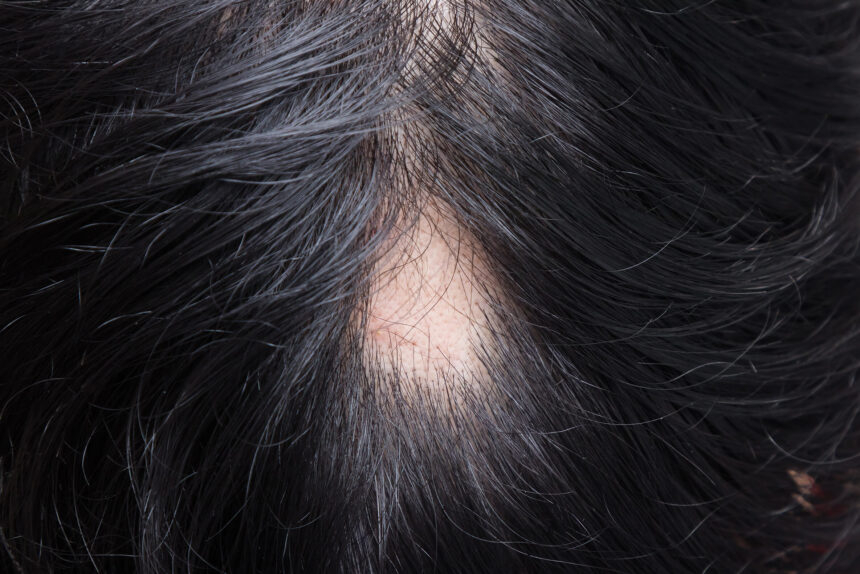Patterned baldness, a common concern that affects many as they age, is often a source of distress for those who experience it. Characterized by a receding hairline and thinning crown, it can impact self-esteem and confidence. While genetics play a pivotal role in this type of hair loss, recent advancements in hair care and natural remedies offer new hope. Among these, pumpkin seed oil has emerged as a potential game-changer, garnering attention for its hair regrowth properties.
We will explore 11 innovative ways to combat patterned baldness, including an in-depth look at how pumpkin seed oil and other natural treatments work and how to effectively incorporate them into your hair care routine. From dietary changes to topical applications, each strategy is designed to offer a holistic approach to managing hair loss. So, whether you’re just beginning to notice thinning hair or have been dealing with patterned baldness for some time, these insights and tips are here to help you on your journey towards healthier, fuller hair.
1. Pumpkin Seed Oil:
- How It Works: Believed to inhibit 5-alpha reductase, reducing DHT levels that cause hair loss.
- How to Use: Massage cold-pressed pumpkin seed oil into the scalp, or take it as an oral supplement.
Topical Pumpkin Seed Oil Scalp Treatment:
Ingredients:
- 2 tablespoons of cold-pressed pumpkin seed oil
- 1 tablespoon of coconut oil (acts as a carrier oil and moisturizes the scalp)
- Optional: 2-3 drops of rosemary essential oil (known for promoting hair growth)
Instructions:
- In a small bowl, mix the pumpkin seed oil with coconut oil. Coconut oil is a great carrier oil and will help in spreading the pumpkin seed oil evenly.
- If using, add the rosemary essential oil to the mixture. This adds an extra boost for hair growth.
- Gently warm the oil mixture by placing the bowl in a larger bowl of hot water. Ensure the oil is comfortably warm to the touch, not hot.
- Part your hair and apply the oil mixture directly to your scalp using your fingertips or a small brush.
- Massage the oil into your scalp for about 5-10 minutes. This helps in improving blood circulation and ensures that the oil is well absorbed.
- Cover your hair with a shower cap and let the treatment sit for at least 30 minutes or overnight for deeper penetration.
- Wash your hair with your regular shampoo, possibly washing twice to ensure all oil is removed.
- For best results, apply this treatment once or twice a week.
Internal Use: Pumpkin seed oil can also be taken orally as a supplement to support hair growth from within.
- Dosage: The typical dosage for pumpkin seed oil capsules is 1 to 2 capsules taken twice daily with meals. It’s important to follow the dosage instructions on the product label.
- Consistency: As with most natural remedies, consistent use over several months is key to seeing results.
2. Scalp Massages:
- How It Works: Increases blood flow to hair follicles, potentially stimulating hair growth.
- How to Use: Gently massage the scalp daily using fingertips for about 5 minutes.
Warm-Up Your Hands: Rub your hands together to warm them up. This makes the massage more comfortable.
Start at the Base of Your Neck: Using the fingertips of both hands, apply gentle pressure and start making small, circular motions at the base of your neck, moving upwards towards the scalp.
Cover the Whole Scalp: Gradually move up from the back of the head to the top, then towards the sides and the area above your forehead. Ensure that you cover the entire scalp area with the circular motions.
Use Gentle Pressure: Apply enough pressure to stimulate the scalp but not so hard that it feels uncomfortable. The motion should be firm but gentle.
Duration: Continue the massage for about 5-10 minutes. Breathe deeply and relax as you do it to enhance blood flow and relaxation.
Finish With a Comb Through: Gently comb through your hair with your fingers or a wide-tooth comb after the massage to remove any tangles.
3. Balanced Diet:
- How It Works: Vitamins and minerals improve hair health; essential nutrients include Vitamins A, C, D, E, iron, and zinc.
- How to Use: Eat a diet rich in leafy greens, nuts, eggs, and fish.
Salmon and Avocado Salad
Ingredients:
- 1 fillet of grilled salmon (rich in omega-3 fatty acids)
- 1 ripe avocado, sliced (packed with vitamins E and C)
- A handful of spinach leaves (contains iron and folate)
- A handful of walnuts, chopped (excellent source of biotin and vitamin E)
- Cherry tomatoes, halved
- Olive oil (healthy fat and vitamin E)
- Fresh lemon juice
- Salt and pepper to taste
Instructions:
- Prepare the Salmon: Grill the salmon fillet until it’s cooked through but still moist. Let it cool and then flake it into large pieces.
- Assemble the Salad: On a plate, arrange a bed of fresh spinach leaves. Add the sliced avocado and cherry tomatoes on top.
- Add the Salmon and Walnuts: Place the flaked salmon on the salad and sprinkle with chopped walnuts.
- Dress the Salad: Drizzle olive oil and fresh lemon juice over the salad. Add salt and pepper to taste.
- Serve Fresh: Enjoy this nutrient-rich salad as a wholesome meal that benefits your hair and overall health.
4. Reducing Stress:
- How It Works: Minimizing stress can slow hair loss.
- How to Use: Practice yoga, meditation, or engage in regular physical activity.
5. Essential Oils:
- How It Works: Oils like rosemary and peppermint stimulate hair growth.
- How to Use: Combine with a carrier oil and apply to the scalp. Rinse after a few hours.
Ingredients:
- 3-4 drops of rosemary essential oil
- 3-4 drops of peppermint essential oil
- 2 tablespoons of carrier oil (such as jojoba oil, coconut oil, or castor oil)
Instructions:
- Mix the rosemary and peppermint essential oils with the carrier oil in a small bowl or bottle.
- Before applying, perform a patch test to ensure you don’t have an allergic reaction to the oils.
- Massage the oil blend into your scalp for several minutes, ensuring even coverage.
- Leave it on for at least 30 minutes or overnight for a more intensive treatment.
- Wash your hair with your regular shampoo, and you may need to shampoo twice to remove all the oil.
- Use this treatment 1-2 times a week.
6. Avoid Harsh Hair Treatments:
- How It Works: Reduces hair damage from chemicals and heat.
- How to Use: Limit use of dyes, bleaches, and heat styling tools.
Avoid:
- Sulfates (such as Sodium Lauryl Sulfate and Sodium Laureth Sulfate): These are common lathering agents in shampoos but can be too harsh, stripping natural oils from your hair and scalp, leading to dryness and irritation.
- Parabens (like Methylparaben and Propylparaben): Used as preservatives, these chemicals can disrupt hormonal balance and may contribute to scalp irritation and potentially impact overall hair health.
- Formaldehyde and Formaldehyde-Releasing Preservatives: Often found in hair straightening products, formaldehyde is a known carcinogen and can cause scalp irritation and hair loss, making it an ingredient best avoided for healthy hair care.
7. Stay Hydrated:
- How It Works: Hydration is key for healthy hair.
- How to Use: Drink at least 8 glasses of water daily.
Infused Water Ingredients:
- 1/2 cucumber, thinly sliced (contains silica, known for hair strength)
- 1 lemon, thinly sliced (rich in vitamin C, vital for collagen production)
- A handful of fresh mint leaves (promotes circulation)
- 2 liters of water
Instructions:
- Prepare the Ingredients: Wash the cucumber, lemon, and mint leaves thoroughly.
- Combine in a Pitcher: Add the cucumber slices, lemon slices, and mint leaves to a large pitcher.
- Add Water: Fill the pitcher with water.
- Let it Infuse: Refrigerate the mixture for at least 3-4 hours or overnight to allow the flavors and nutrients to infuse into the water.
- Serve: Enjoy this refreshing infused water throughout the day
8. Herbal Supplements:
- How It Works: Certain herbs like saw palmetto may reduce hair loss.
- How to Use: Take as directed, but consult a healthcare provider first.
Herbal supplements can be a natural way to support hair health and potentially address patterned baldness. Here’s a detailed look at some beneficial herbs and how they work:
- Saw Palmetto: Believed to block 5-alpha reductase, similar to pumpkin seed oil, saw palmetto can reduce the conversion of testosterone into DHT, a key factor in hair loss.
- Usage: Saw palmetto supplements can be taken orally, but it’s important to consult with a healthcare provider for the appropriate dosage.
- Ginkgo Biloba: Known for improving blood circulation, it can enhance the blood flow to the scalp and hair follicles, promoting hair growth.
- Usage: Ginkgo biloba is available in capsule or liquid extract form.
- Stinging Nettle: Rich in vitamins and minerals that are good for hair health, it also helps in blocking DHT production.
- Usage: Can be taken as a tea, in capsules, or as a liquid extract. It’s also used topically in hair products.
- Peppermint Oil: While not an herb in the traditional sense, peppermint oil is effective in stimulating hair growth and increasing follicle depth.
- Usage: Mix with a carrier oil and apply to the scalp, leaving it on for a few minutes before washing out.
9. Gentle Hair Care:
- How It Works: Prevents additional stress and damage to hair.
- How to Use: Use mild shampoos, avoid tight hairstyles, and gently brush hair.
10. Natural Hair Masks:
- How It Works: Ingredients like egg, avocado, or aloe vera nourish the scalp and hair.
- How to Use: Apply a homemade mask to the hair and scalp once a week.
Ingredients:
- 1 whole egg (rich in protein and biotin)
- 1 tablespoon of olive oil (moisturizes and strengthens hair)
- 1 tablespoon of honey (natural humectant to retain moisture)
Instructions:
- Beat the egg in a bowl.
- Add the olive oil and honey to the beaten egg and mix well to create a smooth paste.
- Apply the mixture evenly to your hair and scalp.
- Cover your hair with a shower cap and leave the mask on for about 20-30 minutes.
- Rinse the mask out with lukewarm water and then shampoo as usual.
This mask can help in moisturizing the scalp, strengthening hair, and promoting overall hair health. Applying it once a week can be a beneficial addition to your hair care routine.
11. Green Tea Rinse:
- How It Works: The antioxidants in green tea may stimulate hair growth and prevent hair loss.
- How to Use: Rinse hair with cooled green tea after shampooing.
Ingredients:
- 2-3 bags of green tea (or 2-3 tablespoons of loose green tea leaves)
- 2 cups of boiling water
Instructions:
- Steep the green tea bags or loose leaves in the boiling water for about 15-20 minutes.
- Allow the tea to cool down to room temperature.
- After shampooing your hair, pour the cooled green tea over your scalp and hair as a final rinse.
- Gently massage it into your scalp for a few minutes.
- Optionally, you can leave it on your hair for up to an hour for a deeper treatment.
- Rinse out with cool water (no need to shampoo again).
- Use this rinse 2-3 times a week for best results.
Conclusion: Managing patterned baldness doesn’t always require medical interventions. These 11 natural, at-home treatments offer accessible and holistic approaches to improve hair health and address hair loss. Each method provides a unique way to nourish and care for your scalp and hair, from the nutrient-rich pumpkin seed oil to stress-reduction techniques and gentle hair care practices. Remember, consistency is key, and it’s important to give these methods time to show results. Additionally, always consult with a healthcare provider before starting any new supplement regimen. With patience and dedication, these natural treatments can be a valuable part of your journey toward healthier hair.








